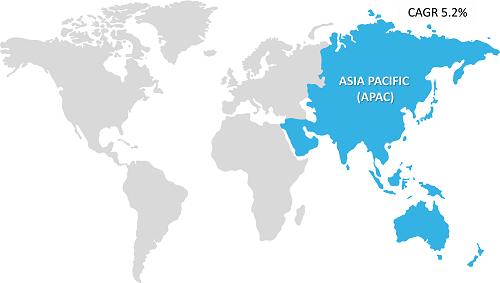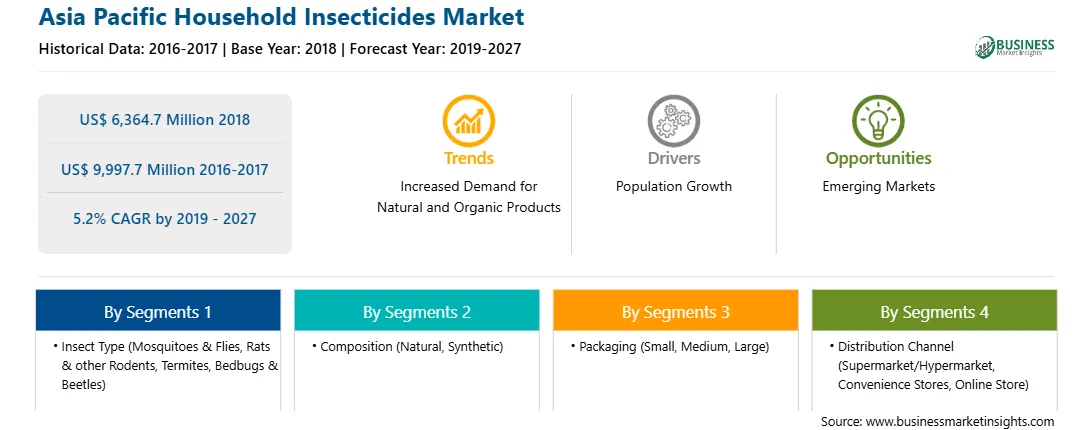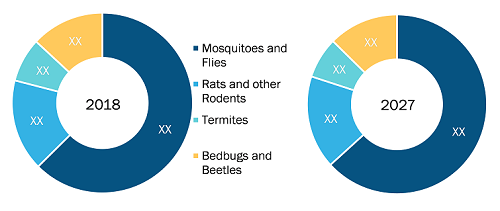The Asia Pacific household insecticides market is accounted to US$ 6,364.7 Mn in 2018 and is predicted to grow at a CAGR of 5.2% during the forecast period 2019 – 2027, to account for US$ 9,997.7 Mn by 2027.
China dominates the Asia Pacific household insecticides market, followed by Japan. The demand for household insecticides made from natural ingredients rather than chemicals is gaining popularity among the consumers in China. This trend is projected to support natural insecticide products. These products are mainly composed of natural ingredients and have a limited impact on the health of the consumers and the environment. The increasing concern for the environment and raising awareness about the harmful effect of chemicals used in the production of household insecticides is driving the consumers towards natural based products. Moreover, the use of natural remedies, along with the use of essential oils to avoid mosquitoes and insects, is a growing trend in China. This factor indirect present high competition to home insecticides producers in China. Some consumers already use essential oils for various other purposes can also use them to avoid mosquitoes and insects in their homes. People even apply essential oils directly onto their skin to protect from insect bites. This may hamper the household insecticide market in China over the forecast period.
Strategic insights for the Asia Pacific Household Insecticides provides data-driven analysis of the industry landscape, including current trends, key players, and regional nuances. These insights offer actionable recommendations, enabling readers to differentiate themselves from competitors by identifying untapped segments or developing unique value propositions. Leveraging data analytics, these insights help industry players anticipate the market shifts, whether investors, manufacturers, or other stakeholders. A future-oriented perspective is essential, helping stakeholders anticipate market shifts and position themselves for long-term success in this dynamic region. Ultimately, effective strategic insights empower readers to make informed decisions that drive profitability and achieve their business objectives within the market. The geographic scope of the Asia Pacific Household Insecticides refers to the specific areas in which a business operates and competes. Understanding local distinctions, such as diverse consumer preferences (e.g., demand for specific plug types or battery backup durations), varying economic conditions, and regulatory environments, is crucial for tailoring strategies to specific markets. Businesses can expand their reach by identifying underserved areas or adapting their offerings to meet local demands. A clear market focus allows for more effective resource allocation, targeted marketing campaigns, and better positioning against local competitors, ultimately driving growth in those targeted areas.

Asia Pacific Household Insecticides Strategic Insights

Asia Pacific Household Insecticides Report Scope
Report Attribute
Details
Market size in 2018
US$ 6,364.7 Million
Market Size by 2027
US$ 9,997.7 Million
Global CAGR (2019 - 2027)
5.2%
Historical Data
2016-2017
Forecast period
2019-2027
Segments Covered
By Insect Type
By Composition
By Packaging
By Distribution Channel
Regions and Countries Covered
Asia-Pacific
Market leaders and key company profiles
Asia Pacific Household Insecticides Regional Insights

Market Insights
Growing emphasis on controlling vector-borne diseases by local and national government bodies to spur the growth of household insecticides
According to the World Health Organization the world wide incidence of dengue has rose by 30 folds in the last 30 years as more and more countries are reporting the outbreak of diseases transmitted by vectors such as mosquitoes. Mosquito-borne diseases are cited among the world's leading causes of death and illness. The World Health Organization predicts that more than 300 million clinical cases are attributable to mosquito-borne diseases each year. Despite great strides over the last five decades, mosquito-borne illnesses continue to pose significant risks to a significant share of the population in poor regions in Asia Pacific. For instance the Indian government has implemented the National Vector Borne Disease Control Programme (NVBDCP) for prevention and control of 6 vector borne diseases which include Malaria, Kala-azar, Dengue, Lymphatic Filariasis, Chikungunya, and Japanese Encephalitis in India. It frames technical guidelines & policies to guide different states to implement the National Vector Borne Disease Control Programme (NVBDCP). The World Health Organization (WHO) also assists federal, state, and local agencies to further protect the public from mosquito-borne diseases such as the West Nile virus.
Insect Type Insights
The Asia Pacific household insecticides market was dominated by the mosquitoes & flies segment in 2018, and it is anticipated that mosquitoes & flies segment would retain its dominance during the 2019–2027 period. There has been a rising demand for mosquito insecticides in the Asia Pacific market. There are two main two leading and most widely used insecticides that are used in the preparation of household insecticides to be effective against mosquitoes known as malathion and permethrin. Malathion is an organophosphate that is quite often used for the elimination of mosquitoes indoors as well as outdoors and also against a wide range of insects. It is used in a small amount as in the mosquito insecticide as it possesses no harm to humans. Permethrin is another chemical that is widely used in the preparation of mosquito insecticides that belongs to the group of chemicals known as pyrethroids. This chemical is mixed with water or oil and is applied as a mist. This chemical is used in the preparation of mosquito insecticides as it damages the central nervous system of the mosquitoes and is noted to cause no harm to the humans as well as animals. The flies have been noted to be responsible for many contagious diseases and the insecticides have been observed to be beneficial for the elimination of these flies. The houseflies are known to rest on sunny surfaces during the day and are known to enter the house during the evenings. The areas where these flies come and rest need to be sprayed with insecticides. Growing concerns regarding the risks associated with vector-borne diseases carried by mosquitoes and flies in urban areas is expected to fuel the growth of the Asia Pacific household insecticides market.
Composition Insights
The Asia Pacific Household insecticides market is bifurcated based on form into natural and synthetic. There has been a rising demand for the household insecticides due to the growing awareness of the effects of the insects such as the mosquitoes, flies and other insects on the human health. On the basis of composition, the Asia Pacific household insecticides market is bifurcated as natural and synthetic. The synthetic segment dominated the Asia Pacific household insecticides market whereas natural segment is expected to grow at fastest growth rate during the forecast period of 2019-2027. Synthetic household insecticides are widely used all over Asia Pacific as they are relatively inexpensive and are very efficient in killing pest and insects. The rising spread of mosquitoes, and other bugs due to deforestation and rapid urbanization is expected to drive the market for synthetic household insecticides market in the forecast period. However, the growing awareness about the ill-effects of synthetic pesticides has swayed many users towards more eco-friendly natural household insecticides. Manufacturers are launching new natural household insecticides to cater to these demand. The market for natural household insecticides is anticipated to grow in the forecast period.
Packaging Insights
On the basis of packaging, the Asia Pacific household insecticides market is bifurcated as small, medium and large. The small segment leads the Asia Pacific household insecticides market whereas medium segment is expected to grow at fastest growth rate during the forecast period of 2019-2027. The small packaging type of household insecticides generally weighs between 250 gm. to 500 gm. It has been noted that the small packaging insecticides have been frequently used as they are easy to port and can be used before the product expires. It has a short period of use due to its acute weight. The easy portability and low weight of the small packaging household insecticides has been a contributing factor for the expansion of the market all over the Asia Pacific.

Strategic insights for the Asia Pacific Household Insecticides provides data-driven analysis of the industry landscape, including current trends, key players, and regional nuances. These insights offer actionable recommendations, enabling readers to differentiate themselves from competitors by identifying untapped segments or developing unique value propositions. Leveraging data analytics, these insights help industry players anticipate the market shifts, whether investors, manufacturers, or other stakeholders. A future-oriented perspective is essential, helping stakeholders anticipate market shifts and position themselves for long-term success in this dynamic region. Ultimately, effective strategic insights empower readers to make informed decisions that drive profitability and achieve their business objectives within the market.

| Report Attribute | Details |
|---|---|
| Market size in 2018 | US$ 6,364.7 Million |
| Market Size by 2027 | US$ 9,997.7 Million |
| Global CAGR (2019 - 2027) | 5.2% |
| Historical Data | 2016-2017 |
| Forecast period | 2019-2027 |
| Segments Covered |
By Insect Type
|
| Regions and Countries Covered | Asia-Pacific
|
| Market leaders and key company profiles |
The geographic scope of the Asia Pacific Household Insecticides refers to the specific areas in which a business operates and competes. Understanding local distinctions, such as diverse consumer preferences (e.g., demand for specific plug types or battery backup durations), varying economic conditions, and regulatory environments, is crucial for tailoring strategies to specific markets. Businesses can expand their reach by identifying underserved areas or adapting their offerings to meet local demands. A clear market focus allows for more effective resource allocation, targeted marketing campaigns, and better positioning against local competitors, ultimately driving growth in those targeted areas.

Strategic Insights
New product development, market initiatives and merger and acquisition were observed as the most adopted strategies in Asia Pacific household insecticides market. Few of the recent developments in the Asia Pacific Household insecticides market are listed below:
2019:
Godrej Consumer Products announced the expansion of Project EMBED (Elimination of Mosquito Borne Endemic Diseases) to Chhattisgarh and Uttar Pradesh. The project will cover 200 villages in the Bastar and Kondagaon districts of Chhattisgarh, and 200 villages in the Bareily and Badaun districts of Uttar Pradesh
Sumitomo Chemical began operations of newly established chemistry research center in takarazuka, hyogo prefecture, Japan. The chemical research center is intended to serve as Sumitomo Chemical's new global R&D base principally for discovery and innovation of crop protection chemicals and household & public hygiene insecticides.
2018:
Neogen Corp launched CyKill Rodenticide Bait an exceptional rodenticide bait that combines superior palatability with the proven active ingredient bromethalin which is an effective non-anticoagulant rodenticide capable of killing rats and mice in a single feeding
2017:
ASIA PACIFIC HOUSEHOLD INSECTICIDES MARKET SEGMENTATION
By Insect Type
By Composition
By Packaging
By Distribution Channel
By Country
Company Profiles
The List of Companies
The Asia Pacific Household Insecticides Market is valued at US$ 6,364.7 Million in 2018, it is projected to reach US$ 9,997.7 Million by 2027.
As per our report Asia Pacific Household Insecticides Market, the market size is valued at US$ 6,364.7 Million in 2018, projecting it to reach US$ 9,997.7 Million by 2027. This translates to a CAGR of approximately 5.2% during the forecast period.
The Asia Pacific Household Insecticides Market report typically cover these key segments-
The historic period, base year, and forecast period can vary slightly depending on the specific market research report. However, for the Asia Pacific Household Insecticides Market report:
The Asia Pacific Household Insecticides Market is populated by several key players, each contributing to its growth and innovation. Some of the major players include:
The Asia Pacific Household Insecticides Market report is valuable for diverse stakeholders, including:
Essentially, anyone involved in or considering involvement in the Asia Pacific Household Insecticides Market value chain can benefit from the information contained in a comprehensive market report.